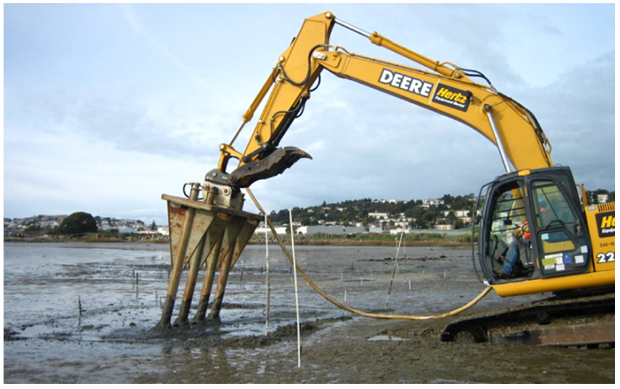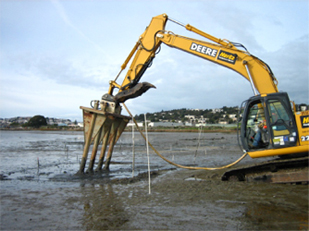|
Site Narrative
HPNS is situated on a peninsula in the southeast corner of San Francisco, CA. The peninsula is
bounded on the north, east, and south by San Francisco Bay and on the west by the Bayview Hunters Point district (click here to view figure). HPNS comprises about 928 acres, with approximately 400 acres of offshore sediments.
From 1945 to 1974, the Navy used HPS for predominantly ship repair and maintenance. HPS was deactivated in 1974 and remained relatively unused until 1976, when it was leased to a private ship repair company. In 1986, the Navy resumed occupancy of HPS, but closed the Base in 1991. HPNS was placed on the NPL in 1989, and was the subject of a Federal Facilities Agreement between EPA and the Navy in 1990. Cleanup is on-going in both the uplands, and offshore areas in accordance with CERCLA. Additional information on HPNS and site documentation may be found at both the EPA and Navy websites for HPNS.
Treatability Studies
Treatability studies were conducted by Dr. Richard Luthy and colleagues of Stanford University under three SERDP/ESTCP projects (Table 1). An important finding from the treatability study was that regenerated activated carbon (RAC) demonstrated higher sequestration than did virgin activated carbon (VAC). RAC was obtained from US Filter-Westates with an original size range of 600-2400 micron. The RAC sample was then reground and re-sieved at Stanford to obtain a 75-250 micron size range. Although this size range was similar to the 75-300 micron VAC sample obtained from Calgon Corporation, the small difference in particle size may have been a factor affecting the better performance of RAC compared to VAC. AC performance depends on particle radius; specifically the uptake kinetics are strongly dependent on AC particle size. The investigation team indicated that it is probable that the RAC samples contained on average more fine-sized particles than VAC samples despite the overall similar size range.
Based on the treatability study results, the investigation team had planned on using RAC in the field treatments. The RAC purchased from US Filter Westates at a cost of $1.88/pound included the costs for remilling, resieving, and repackaging their original product (ACNS 8x30 with 600-2400 micron size range, $0.45/pound) to the Stanford-requested 75-300 micron size range (50x200). In comparison, the cost of virgin activated carbon (TOG 50x200) from Calgon was quoted as $2.49/pound. However, the use of RAC was hampered by a site-specific condition for the test sites at HPS. A concern of possible radiological contamination at the HPS South Basin site banned the addition of any material having a radioactivity signal larger than the site background values measured during a radiation survey, even though the area was eventually determined as uncontaminated. As one of the RAC samples slightly exceeded the very strict background limit due to naturally occurring material (probably inherent in the parent coal from which the activated carbon was derived), the RAC could not be used.
As a result, the VAC from Calgon was used for the pilot project.
Engineering Specifications and Contracting
Engineering specifications may be found in the Quality Assurance Project Plan for the project (Appendix A of the ER-200510 Final Report).
Four plots of approximately 370 ft2 were located within the tidal flat region of HPS South Basin, in the southeast portion of the cove. The location was selected as it was accessible from the shore and away from possible impacts of any potential on-going PCB releases on the north side of the cove.
Placement Methods
An important component of this project was the selection of two contractors with commercially available equipment that could be used to deploy and mix AC into sediments. The plot size and orientation depended on the mechanical movements of the mixing arms on each piece of equipment. The four plots were located along a tide contour line in an attempt to ensure that the benthic communities that exist in these plots were similar. Preliminary sediment cores taken from the four plots indicated that the sediment had a similar texture across all four plots. As shown in the site figure from the field report, the equipment was used in three of the four plots.
Actuated Rototiller
For the Hunters Point 2005 AC demonstration project (ESTCP Report ER-200510), a commercially-available amphibious-mounted rototiller, the ???Aquamog??? was used to place and mix the AC into one of the treatment plots. Owned by Aquatic Environments, Inc. (AEI, Alamo CA), the Aquamog is equipped with a rotovator attachment that is typically used to disrupt weed growth in marshy areas.
The AEI Aquamog plots were located on the western side of the test area (Plots C and D). As shown in the site figure, the Aquamog has an arm that can mix a 6-foot swath and move in a radial fashion for Plots C and D.
At Hunters Point, the Aquamog was deployed on the water during high tide and allowed to settle onto the sediment surface at low tide to place the PAC. The PAC was manually deployed on the surface of the plot at low tide and then mixed into sediment by the rotovator arm for about half an hour total over the plot. The depth of the mixing was controlled by the speed and downward pressure of the rotovator. The overall operation by Aquamog was reported as being very successful; the AC-sediment mixing was immediately visually confirmed. The limitation to the equipment for PAC placement was that the treatable sediment area was limited to a 6-foot swath (the swing-length of the rotorvator) per one tidal cycle, because the barge units its mobility was limited to high tides. A second limit was that a second amphibious support vehicle was necessary to support placement onto the demonstration site.
AEI Aquamog System

Excavator-Mounted Rake Injectors
A second system tested in the 2006 Hunters Point project was an excavator-mounted rake injection system. Owned by Compass Environmental, Inc. (CEI, Stone Mountain, GA), the system was adapted from a commercially available soil/sediment stabilization that uses a set of hollow ???forks??? to inject and then mix (???rake???) the cement grout. For Hunters Point, the rake equipment was mounted to a track-mounted conventional excavator that mobilized out into the intertidal test plots during low tides. The PAC slurry was mixed onshore, and pumped to the rig, and then injected and mixed into the upper one foot of tidal zone sediments.
An advantage of this system is that CEI was able to record data such as slurry flow rate, slurry density, pump time, and slurry volume pumped into each test plot; this provided the data necessary to demonstrate that the requisite carbon mass has been added to test plot. This disadvantage of this equipment was that the equipment was restricted to intertidal areas, and that the total weight of the equipment limited the application to areas where the sediment was sufficiently stable to support the equipment weight. For this project, the CEI injector was unable to complete the mixing control for Plot G (Injector, Mix Only) since the sediment surface of this plot was not stable enough to support the device's weight.
CEI Injector System

Performance Monitoring
Pre- and post-placement monitoring included:
- Bulk sediment core and grab samples of PCBs, TOC, black carbon and grain size.
- Passive Samplers (SPMD and PE) for PCB congeners.
- Field-deployed clam bioaccumulation studies.
- Post-treatment bioassays (amphipods and polychaetes) on collected sediment samples.
- Benthic community analyses
The Final Report for ESTCP Project ER-200510 includes detailed results and the supporting data for the pre- and post-treatment plots. A summary of the findings from the report were that field-exposed AC retained a strong stabilization capability to reduce aqueous equilibrium PCB concentrations by as much as 95% depending on AC dose. This was demonstrated also in long term SPMD exposure tests lasting more than seven months. The time series test results showed the AC continually reduced SPMD uptake of PCBs, achieving reductions ranging from 76% for tetra-chloro PCBs to 42% for hepta-chloro PCBs. A strong AC-dose response effect was observed both for aqueous equilibrium PCB concentrations and Macoma nasuta PCB bioaccumulations. Adverse impacts to indigenous amphipods and benthic community were observed during the entire assessment period. Overall, the AC treatment did not impact macro-invertebrate benthic community composition, richness, or diversity.
Costs
Stanford field demonstration project costs may be found in Table 5 of the ER-200510 Cost and Performance Report. A projected cost for the AC addition that was included in the 2008 Feasibility Study for HP, with comparisons to the estimated dredging and conventional capping costs, are also in the Cost and Performance Report in Figure 14 and Table 7.
|





